Over the last couple of weeks, I've been recreating the first level of Dishonored. In this blog post, I will provide a brief overview of how I accomplished this, as well as analyse what I learned from the level.
The process, in short:
My first task was to find an object that I could use as a measure for the scale of the level. For this, I chose a train cart because it is the length of one un-upgraded blink, which is an ability in Dishonored that teleports the player a set distance horizontally (it is worth noting that it also teleports vertically, but this distance is different from the horizontal distance). With that, I then started measuring the lengths of streets and buildings to the best of my ability. With the copious use of the ProBuilder addon in Unity, I began building out the level, one street at a time. My goal for the recreation was to achieve the layout of the original level. With all gameplay-affecting elements retained in the level. And this is the result of that process. I tried to keep the scale as close to the original as possible, but it is not exactly the same due to the limitations of my measuring tools.
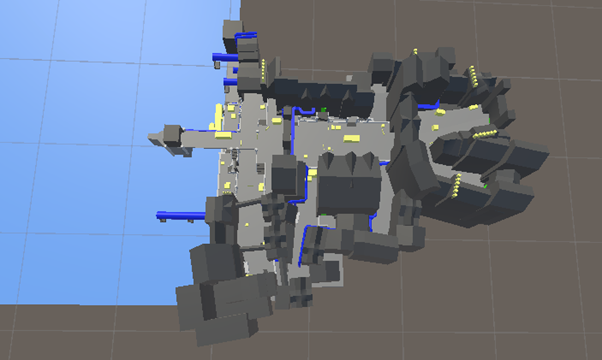
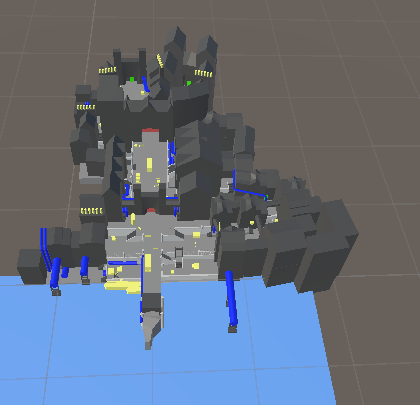
All the yellow objects are clutter objects, such as boxes, barriers, and so on. The semi-translucent red planes represent the walls of light in the game, which present a deadly barrier. The Green rectangles are doors that lead to other levels of the mission. The blue objects are various pipes, which are both decorative and integral to the gameplay. For more information about the process of recreating the level, you can go to my portfolio piece for this level here.
Analysis:
To analyse the level, the purposes of the level must be established. The purposes of this level, as I identify them, are:
1. Teach players about the general structure of future levels
2. Teach players about how to use their abilities in the context of a mission
3. How to navigate future levels
4. To be replayable.
5. To immerse the player in the game's world.
2. Teach players about how to use their abilities in the context of a mission
3. How to navigate future levels
4. To be replayable.
5. To immerse the player in the game's world.
For the purpose of analysing the grey-boxed version of the level I've made, I will mostly be covering aspects of the level that serve goals 1-3
It is worth noting that, prior to this level, players had only been presented with linear levels, which served as tutorials for movement, stealth, combat, and the blink ability. This level is the first where the player is thrown into an open environment and must utilise their abilities to reach the end of the level. Furthermore, this level will be reused later on in the game for the second mission, which gives the level its last two goals.
With the goals of the level defined, we start the level at the docks area:
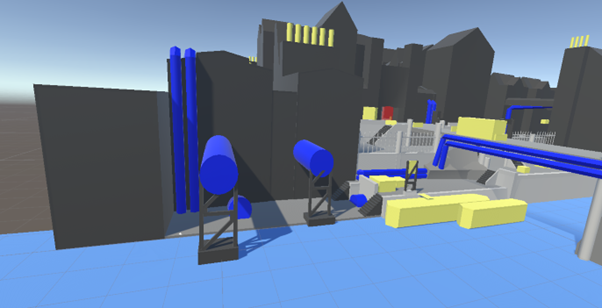
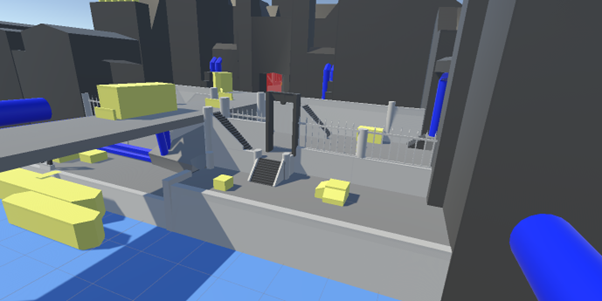
This is an entirely linear area, with no way of straying from the path. This functions as a safe area, giving the player time to take in the general mood and atmosphere of the city at their own pace. In this area, the game also makes clever use of framing to tell the player about the city.

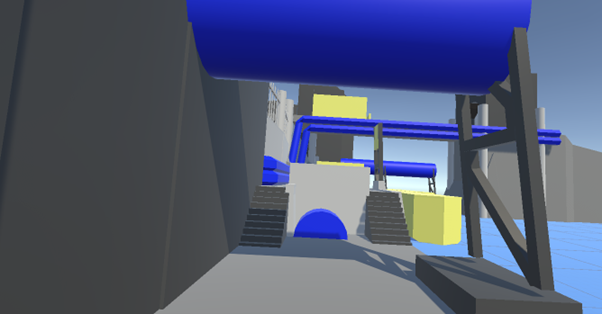
At the start of the game, the player is confronted very directly by the corpse train on the bridge and the guards who are throwing the dead bodies out from the bridge and down onto the barge at the docks. This alone tells the player a great deal about the world and also serves as a way of introducing the player to future enemies whom they must deal with. Another thing that is also shown here is the house at the end of the bridge, which serves as a strong point of interest and guides the players to explore it when they can.
From the docks area, the player can go in two distinct directions: They can either climb the stairs up, which leads directly up to the bridge, or they can go to the street, which runs to the right of the bridge area.
It is worth noting that the bridge and the street below are connected via several different routes. This is a general theme of the entire level. There is always more than one way to reach the same point, and at this level, the design communicates that point clearly to the player by directly showing the interconnectedness.
Staying at the bridge area for a moment, the player is given their first major challenge: the first wall of light, which will kill the player if they try to go through. Here again, the level design shows the player that there is more than one way to approach.

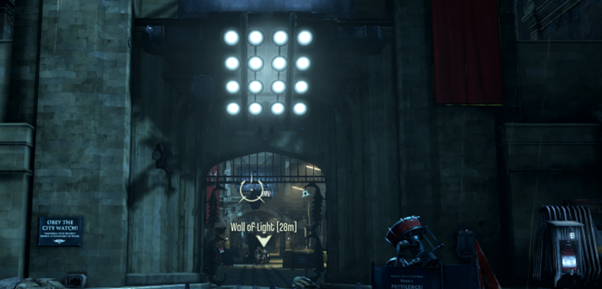
The player can blink onto the pipes to the left and right of the wall of light and use the roofs as their way forward. Because this also serves as the tutorial for the walls of light, the power for the wall is placed out front, along with a device that players can use to turn the wall to their side.
If we decide that we don't want to go this way and opt for the lower road instead, we are presented with a blind way to the left and a left-hand turn to the right.
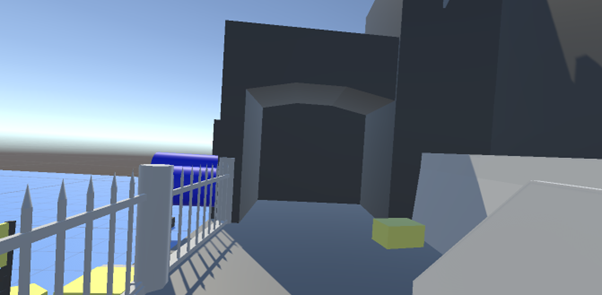

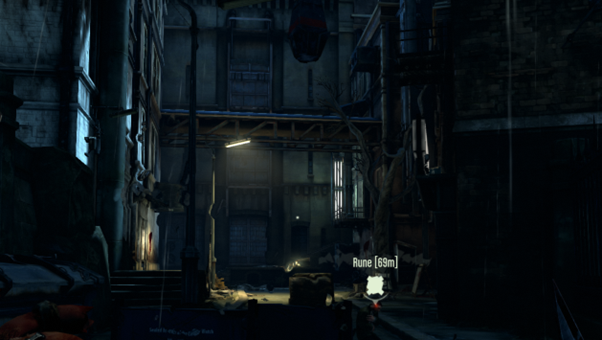
Furthermore, the right way also features a balcony with a clearly open door. This is the first interior that we can access. To further incentivise the player to explore this direction, there is also a rune in that direction, which serves as the upgrade resource for the player's powers.
Going to the end of the road, we approach the corner.
Here, a door to a side area for this first level lies directly ahead, framed by an arch, ensuring that the players will notice it.
As the player approaches that door, they reach another corner.
Here, the bridge from before is clearly visible between the buildings, as well as a straightforward way of getting to it via the pipe on the left. Here again, the level design shows the player how there are often less obvious ways of reaching a place and that straying from the direct route can lead to bonus resources.
There is also a pipe on the right, which alerts the player to the presence of something to the right.
And indeed, there is a raised platform with a locked door to the right. The door will be open the next time the player reaches this level. This closed door acts as an intrigue for the player, who will likely go check it out the next time they enter the level and thus be shown a new side area. Furthermore, this area also has access to a whole new area of the level.
Another low road, which also goes beneath the main bridge of the level, this area allows the player to return to the bridge, but also hints that there may be more to find by continuing the road beyond the main bridge area.
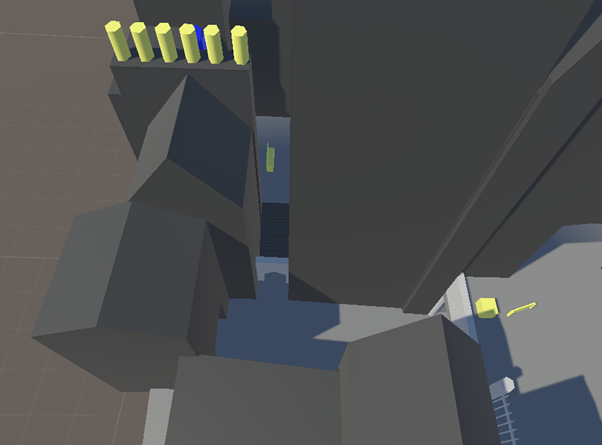
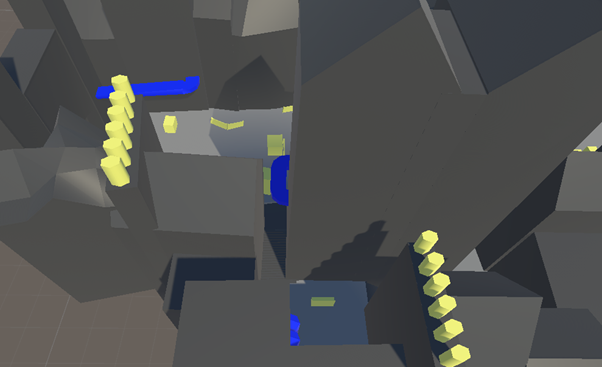
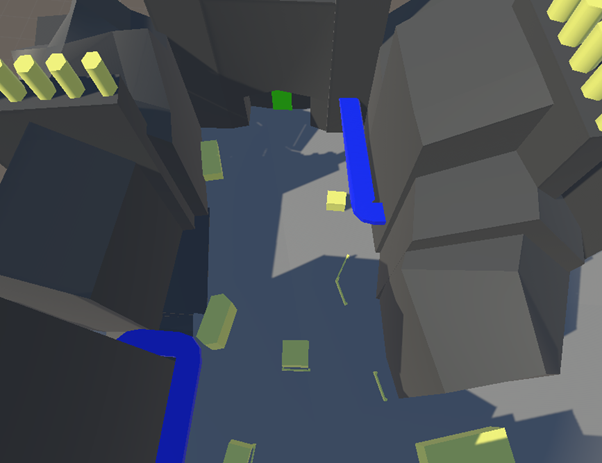
And indeed, hidden at the end of the road is a small side that leads directly to the end of the level and to the next level of the mission. An interesting part of this path is that even if the player takes the most direct route to the end of the level, they are likely to learn of its existence when they reach the end of the level.
The path is shown at the end of the level, with pipes going around a corner, and it is framed by a guard post. Players who skip side paths are likely to still learn that the side routes exist by being shown the end of one here directly before they exit this level.
Another use of foreshadowing can also be seen here, as the entrance to the second mission's main area can be seen to the right. Here, the player is again shown what they can look forward to.
If we now go back to the main bridge.
Here, we see the interconnectedness of this level taken to its maximum. This part of the level is connected to all other parts of the level via several paths, and most of these paths are pretty clearly shown to the player via indicators in the shape of stairs and pipes.
This area is perhaps the distillation of the design philosophy of the entire level, namely that of creating an interconnected level that gives the player freedom to approach the objective in multiple ways. There is furthermore ample opportunity for the player to use the blink ability in order to climb roofs and navigate the level.
Hiding spots are scattered across the street, and a second wall of light presents an escalation of the initial challenge. This time, the method of deactivating it is less obvious, and the player will have to think more about their abilities to get past it, or explore the level and find the alternative route, as shown before. Regardless of how the player approaches this challenge, they are sure to gain a great deal of insight into how the game works.
This is by far not the best level of the game. Still, it is representative of the general structure and philosophy of the rest of the game, with levels where there are almost always more than one way to get to the desired location and where there are lots of interconnected ways of approaching each challenge they present. The level has, in its design, taught the player a lot about how to use their blink ability, which will likely be one of the main abilities they are going to use in the future, as well as what they can expect from the game in general.